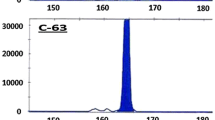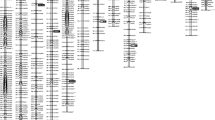Abstract
Sugarcane varieties are complex polyploids carrying in excess of 100 chromosomes and are derived from interspecific hybridisation between the domesticated Saccharum officinarum and the wild relative S. spontaneum. A map was constructed in  , an Australian cultivar, from a segregating F1 population, using 40 amplified fragment length polymorphism (AFLP) primer combinations, five randomly amplified DNA fingerprints (RAF) primers and 72 simple sequence repeat (SSR) primers. Using these PCR-based marker systems, we generated 1,365 polymorphic markers, of which 967 (71%) were single-dose (SD) markers. Of these SD 967 markers, 910 were distributed on 116 linkage groups (LGs) with a total map length of 9,058.3 cM. Genome organisation was significantly greater than observed in previously reported maps for Saccharum spp. With the addition of 123 double-dose markers, 36 (3:1) segregating markers and a further five SD markers, 1,074 markers were mapped onto 136 LGs. Repulsion phase linkage detected preferential pairing for 40 LGs, which formed 11 LG pairs and three multi-chromosome pairing groups. Using SSRs, double-dose markers and repulsion phase linkage, we succeeded in forming 127 of the 136 LGs into eight homo(eo)logy groups (HG). Two HGs were each represented by two sets of LGs. These sets of LGs potentially correspond to S. officinarum chromosomes, with each set aligning to either end of one or two larger LGs. The larger chromosomes in the two HGs potentially correspond to S. spontaneum chromosomes. This suggestion is consistent with the different basic chromosome number of the two species that are hybridised to form sugarcane cultivars, S. spontaneum (x=8) and S. officinarum (x=10), and illustrates the structural relationship between the genomes of these two species. The discrepancy of coverage between HGs highlights the difficulty in mapping large parts of the genome.
, an Australian cultivar, from a segregating F1 population, using 40 amplified fragment length polymorphism (AFLP) primer combinations, five randomly amplified DNA fingerprints (RAF) primers and 72 simple sequence repeat (SSR) primers. Using these PCR-based marker systems, we generated 1,365 polymorphic markers, of which 967 (71%) were single-dose (SD) markers. Of these SD 967 markers, 910 were distributed on 116 linkage groups (LGs) with a total map length of 9,058.3 cM. Genome organisation was significantly greater than observed in previously reported maps for Saccharum spp. With the addition of 123 double-dose markers, 36 (3:1) segregating markers and a further five SD markers, 1,074 markers were mapped onto 136 LGs. Repulsion phase linkage detected preferential pairing for 40 LGs, which formed 11 LG pairs and three multi-chromosome pairing groups. Using SSRs, double-dose markers and repulsion phase linkage, we succeeded in forming 127 of the 136 LGs into eight homo(eo)logy groups (HG). Two HGs were each represented by two sets of LGs. These sets of LGs potentially correspond to S. officinarum chromosomes, with each set aligning to either end of one or two larger LGs. The larger chromosomes in the two HGs potentially correspond to S. spontaneum chromosomes. This suggestion is consistent with the different basic chromosome number of the two species that are hybridised to form sugarcane cultivars, S. spontaneum (x=8) and S. officinarum (x=10), and illustrates the structural relationship between the genomes of these two species. The discrepancy of coverage between HGs highlights the difficulty in mapping large parts of the genome.




Similar content being viewed by others
References
Al-Janabi SM, Honeycutt RJ, McClelland M, Sobral BWS (1993) A genetic linkage map of Saccharum spontaneum L. ‘SES 208’. Genetics 134:1249–1260
Bentley S, Bassam BJ (1996) A robust DNA amplification fingerprinting system applied to analysis of genetic variation within Fusarium oxysporum f.sp. cubense. J Phytopathol 144:207–213
Bhat SR, Gill BS (1985) The implication of 2n egg gametes in nobilisation and breeding of sugarcane. Euphytica 34:377–384
Cordeiro GM, Taylor GO, Henry RJ (2000) Characterisation of microsatellite markers from sugarcane (Saccharum sp.), a highly polymorphic species. Plant Sci 155:161–168
Cuadrado A, Acevedo R, Moreno Díaz de la Espina S, Jouve N, de la Torre C (2004) Genome remodelling in three modern S. officinarum × S. spontaneum sugarcane cultivars. J Exp Bot 55:847–854
D’Hont A, Lu YH, Gonzālez De Lēon D, Grivet L, Feldmann P, Lanaud C, Glaszmann JC (1994) A molecular approach to unravelling the genetics of sugarcane, a complex polyploid of the Andropogoneae tribe. Genome 37:222–230
D’Hont A, Grivet L, Feldmann P, Rao S, Berding N, Glaszmann J-C (1996) Characterisation of the double genome structure of modern sugarcane cultivars (Saccharum spp.) by molecular cytogenetics. Mol Gen Genet 250:405–413
D’Hont A, Ison D, Alix K, Roux C, Glaszmann J-C (1998) Determination of basic chromosome numbers in the genus Saccharum by physical mapping of ribosomal RNA genes. Genome 41:221–225
D’Hont A, Paulet F, Glaszmann J-C (2002) Oligoclonal interspecific origin of ‘North Indian’ and ‘Chinese’ sugarcanes. Chromosome Res 10:253–262
Gardiner JR, Coe EH, Melia-Hancock S, Hoisington DA, Chao S (1993) Development of a core RFLP map in maize using immortalized F2 population. Genetics 134:917–930
Grivet L, Arruda P (2001) Sugarcane genomics: depicting the complex genome of an important tropical crop. Curr Opin Plant Biol 5:122–127
Grivet L, D’Hont A, Roques D, Feldmann P, Lanaud C, Glaszmann JC (1996) RFLP mapping in cultivated sugarcane (Saccharum spp.): genome organisation in a highly polyploid and aneuploid interspecific hybrid. Genetics 142:987–1000
Hoarau JY, Offmann B, D’Hont A, Risterucci AM, Roques D, Glaszmann JC, Grivet L (2001) Genetic dissection of a modern sugarcane cultivar (Saccharum spp.). 1. Genome mapping with AFLP markers. Theor Appl Genet 103:84–97
Hoisington D (1992) Laboratory protocols. CIMMYT Applied Molecular Genetics Laboratory, Mexico City
Irvine JE (1999) Saccharum species as horticultural classes. Theor Appl Genet 98:186–194
Lander ES, Green P, Abrahamson J, Barlow A, Daly MJ, Lincoln SE, Newburg L (1987) mapmaker: an interactive computer package for constructing primary linkage maps of experimental and natural populations. Genomics 1:174–181
Lu YH, D’Hont A, Walker DIT, Rao PS, Feldmann P, Glaszmann JC (1994) Relationships among ancestral species of sugarcane revealed with RFLP using single copy maize nuclear probes. Euphytica 78:7–18
Ming R, Liu SC, Lin YR, da Silva J, Wilson W, Braga D, van Deynze A, Wenslaff TF, Wu KK, Moore PH, Burnquist W, Sorrells ME, Irvine JE, Paterson AH (1998) Detailed alignment of Saccharum and Sorghum chromosomes: comparative organisation of closely related diploid and polyploid genomes. Genetics 150:1663–1682
Ming R, Liu SC, Bowers JE, Moore PH, Irvine JE, Paterson AH (2002) Construction of a Saccharum consensus genetic map from two interspecific crosses. Crop Sci 42:570–583
Moore G, Devos KM, Wang Z, Gale MD (1995) Cereal genome evolution, grasses, line up and form a circle. Curr Biol 5:737–739
Mudge J, Andersen WR, Kehrer RL, Fairbanks DJ (1996) A RAPD genetic map of Saccharum officinarum. Crop Sci 36:1362–1366
Qu L, Hancock JF (2001) Detecting and mapping repulsion-phase linkage in polyploids with polysomic inheritance. Theor Appl Genet 103:136–143
Roach B (1972) Nobilisation of sugarcane. Proc Int Soc Sugar Cane Technol 14:206–216
Rossi M, Araujo PG, Paulet F, Garsmeur O, Dias VM, Chen H, Van Sluys M-A, D’Hont A (2003) Genomic distribution and characterization of EST-derived resistance gene analogs (RGAs) in sugarcane. Mol Genet Genomics 269:406–419
da Silva JAG, Sorrells ME, Burnquist WL, Tanksley SD (1993) RFLP linkage map and genome analysis of Saccharum spontaneum. Genome 36:782–791
da Silva JAG, Honeycutt RJ, Burnquist W, Al-Janabi SM, Sorrells ME, Tanksley SD, Sobral BWS (1995) Saccharum spontaneum L. ‘SES 208’ genetic linkage map combining RFLP and PCR-based markers. Mol Breed 1:165–179
Vos P, Hogers R, Bleeker M, Reijams M, van de Lee T, Hornes M, Frijters A, Pot J, Peleman J, Kuiper M, Zabeau M (1995) AFLP: a new technique for DNA fingerprinting. Nucleic Acids Res 23:4407–4414
Wu KK, Burnquist W, Sorrells ME, Tew TL, Moore PH, Tanksley SD (1992) The detection and estimation of linkage in polyploids using single-dose restriction fragments. Theor Appl Genet 83:294–300
Acknowledgements
This project was supported in part by a research grant from the Australian Sugar Research and Development Corporation.
Author information
Authors and Affiliations
Corresponding author
Additional information
Communicated by P. Langridge
Denotes variety covered by Australian plant breeding rights.
Rights and permissions
About this article
Cite this article
Aitken, K.S., Jackson, P.A. & McIntyre, C.L. A combination of AFLP and SSR markers provides extensive map coverage and identification of homo(eo)logous linkage groups in a sugarcane cultivar. Theor Appl Genet 110, 789–801 (2005). https://doi.org/10.1007/s00122-004-1813-7
Received:
Accepted:
Published:
Issue Date:
DOI: https://doi.org/10.1007/s00122-004-1813-7




